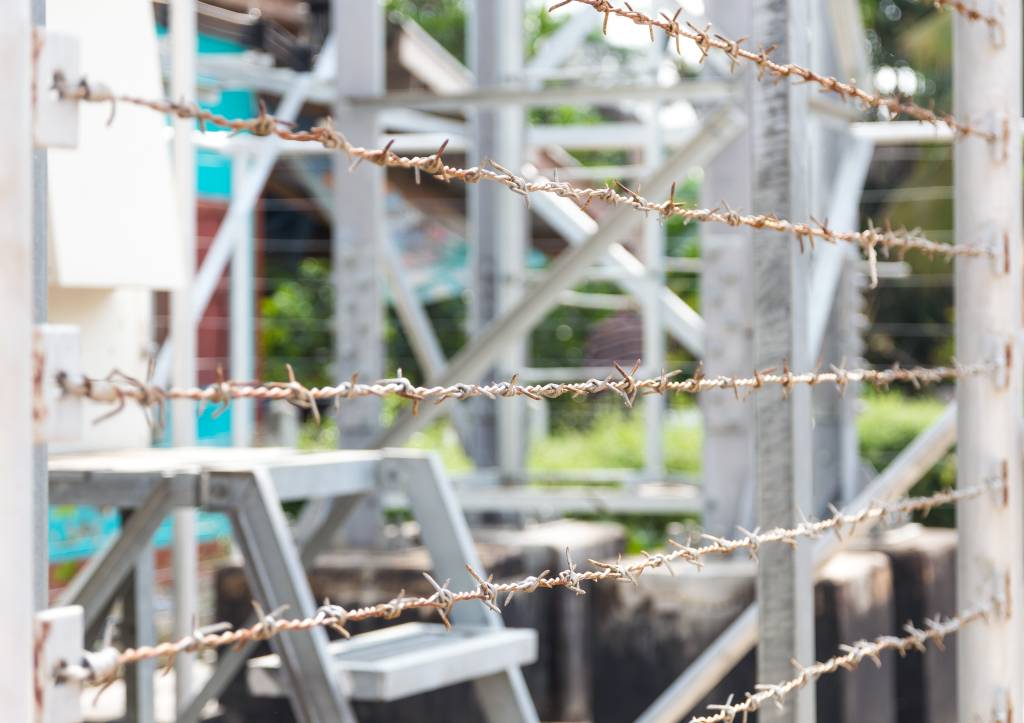The term “hog wire” typically refers to hog fencing, also known as hog panels. Which is a less expensive alternative to welded wire fencing used to corral animals. Farmers and ranchers frequently use hog wire to confine pigs, hogs, or wild boar. What I’ve noticed more and more lately (and admired) are hog wire panels: used for fences, gates, and trellises. A mainstay on ranches for decades, hog wire panels been discovered by homeowners and landscape designers as an affordable, low-profile solution for maintaining a wide-open view while keeping animals out. They even possess a certain elegance.
What are hog wire panels?
Also called cattle or livestock panels, hog wire panels are made of steel rods welded at every intersection and galvanized with a zinc coating. Feed- and livestock-supply companies sell different styles with different rod gauges. You’ll want a heavy gauge for a longer-lasting fence that won’t sag.
How do you construct a hog wire fence?
Four-foot-high hog wire panels, a common size, come in 16-foot lengths. Which are usually cut in half to make 8-foot sections. For posts, my local landscape contractor recommends using 4-by-4-inch pressure-treated Douglas fir, set in concrete. The stringers (or rails) at the top and bottom of the fence could be 2-by-4-inch pressure-treated fir or redwood. You can either staple the hog panels to the posts, or sandwich the panels between 1-by-1-inch pieces of redwood to hide the ends of the wire.
Most homeowners in my Northern California town are concerned about keeping deer out of gardens. So they often add a 2-by-12-inch kickboard at the bottom to make the overall fence 6 feet high. You need at least that to keep deer out.
Which plants grow well on a hog wire fencing?
One of the nice things about a hog wire fence is that it acts as a trellis. Almost any vining plant will grow on hog wire: jasmine, clematis, potato vine, hardenbergia, and many more. Climbing roses can be tied against the wire. You’ll have a living fence in no time, if that’s what you want. The one vine that doesn’t do well on metal wire is ivy, because it uses suckers to climb.
How much does a hog wire fences cost?
Hog wire fencing is slightly more expensive than chain-link but less expensive than a complete cedar fence. If you’re utilising timber posts and rails. The panels are available in 16-foot lengths and 3 to 8-foot heights. For instance, a fence in my region that is 16 feet long and has panels that are 4 feet high costs roughly $50 per linear foot. The fence can be reasonably priced if you’re doing the work yourself.
If you hire a landscaper or fencing contractor, you can have a 6-foot-high wood and wire fence erected for $35 to $50 each running foot, depending on the local going rate for labour. If you add a 5-foot fence instead of the 1-foot stringer at the bottom, the cost per running foot lowers from $25 to $40, or around $10.
Hog Wire Fences Recap
Pros:
- Inexpensive–less than a wood fence
- Durable and strong
- Preserves the view
- Flexible–can bend
- Easy to install
- Keeps out larger animals such as dogs and deer
Cons:
- Edges can be sharp, and must be covered with trim
- Does not provide privacy
- Does not deter smaller pests such as mice, voles, and raccoons
- Gardeners may not like the texture of the wire
- Can be unsightly in areas
- Not permanent or permanent enough
- Does not protect against wind damage
- Often requires concrete posts, or trellises made of wood.
- Wear and tear on metal is possible over time.
Some additional fence tips from the Department of Wildlife, Fish and Parks:
Hogs can be taught to avoid being in an enclosed space. Aluminum foil or electric fencing are effective visual barriers. Because feral hogs are able to locate their food source, poisoning them frequently fails. Use poison with extreme caution and in a method that is safe for you, the pigs, and your pets.
Hog fences offer a solid, lovely method to maintain an open view while still keeping animals at away, whether you’re using it to keep hogs in or keep them out of your garden.
The term “hog wire” typically refers to hog fencing, also known as “hog panels,” which is a less expensive alternative to welded wire fencing used to corral animals. Farmers and ranchers frequently use hog wire to confine pigs, hogs, or wild boar.
It is also used in a variety of non-farming and non-ranching applications. Some uses include:
Hog wire fencing is also a popular way to substitute for privacy fences as it is less obtrusive than traditional wood or chain link privacy fences. Because the metal mesh associated with hog wire fencing allows visibility through the fence and potentially through adjoining properties, it may not offer the level of privacy expected by some home owners.
The “cattle panel” or “hog wire” used for fencing cattle is also referred to as hardware cloth in the UK and by several other names, but it is not just a type of hardware cloth. The term “hog wire” is used to refer specifically to a kind of steel barrier mounted on posts or other supports and sold as livestock fencing.
Before the advent of chain link fencing, hog wire was primarily used in North America to make fences around gardens. Around the same time, hog wire fencing was also used to make temporary fences and corrals. Since hog wire is still available commercially, gardeners can use it to make their own fences.
Hog wire fencing can be strung around trees in a manner similar to chain link fencing. The only difference is that hog wire has a number of bushings or holes on one or both sides so that livestock cannot easily pass through it; only the animals can pass through. This is achieved by pressing the hog wire between a coarse metal rod and a hard anvil, usually as part of the manufacturing process.
Hog wire is also used to make trellis walls and fence posts that are frequently used with vining plants.
Hog wire fencing is not supposed to be used for keeping out deer, which can make it extremely unsightly around gardens. Where hog wire is used for this purpose, the fixtures it creates become unsightly as well; it loses its original value as a sustainable fence.
Before the advent of chain link fence, hog wire was also sold as animal containment material or as a means of teaching animals how to behave. It was often used in conjunction with electric fencing to keep an animal contained.
Conclusion
Hog wire fences are useful in a variety of different applications, but many people use it to keep hogs at bay. If you have a garden and you want to keep the hogs out, hog wire fencing is an inexpensive option that works well. Many farmers and ranchers also use hog wire fencing to contain their livestock.
By using hog wire fencing in your garden or around your livestock, you can keep animals out while keeping the natural grasses and bushes in tact.




